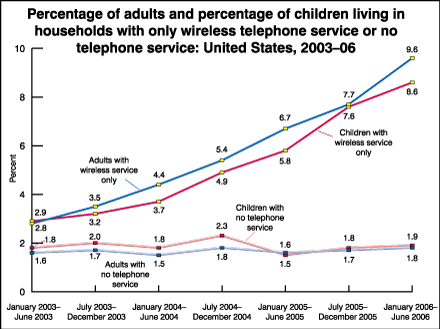Wireless Substitution: Preliminary Data from the January-June 2006 National Health Interview Survey
by Stephen J. Blumberg, Ph.D., and Julian V. Luke, Division of Health Interview Statistics
Preliminary results from the January-June 2006 National Health Interview Survey (NHIS) indicate that the number of households with only wireless telephones continues to increase. During the first 6 months of 2006, one out of eight American homes did not have a landline telephone. Of those homes without a landline telephone, 84 percent had at least one working wireless telephone. These are the most up-to-date estimates available from the federal government concerning the size of this population.
The estimates are based on in-person interviews completed as part of the NHIS. This cross-sectional survey of the U.S. civilian noninstitutionalized population, conducted continuously throughout the year, is designed to collect information on health status, health-related behaviors, and health care utilization. The survey also includes information about household telephones and whether anyone in the household has a wireless telephone (also known as a cellular telephone, cell phone, or mobile phone). From January through June 2006, interviews were completed in 16,009 households. These households included 29,842 adults aged 18 years and over and 11,670 children aged 17 years or younger.
Because NHIS is conducted throughout the year and the sample is designed to yield a nationally representative sample each week, data can be analyzed quarterly. Weights are created for each calendar quarter of the NHIS sample. NHIS data weighting procedures have been described in more detail in an NCHS published report (Series Report Number 2, Volume 130 [PDF - 300 KB]). Because the estimates using the January-June 2006 data are being released prior to final data editing and final weighting, they should be considered preliminary and may differ slightly from estimates using the final data files.
Among the findings from the first 6 months of 2006, approximately 10.5 percent of households do not have a traditional landline telephone, but do have at least one wireless telephone. Approximately 9.6 percent of all adults—21 million adults—live in households with only wireless telephones; 8.6 percent of all children—more than 6 million children—live in households with only wireless telephones.
Two percent of households do not have any telephone service (wireless or landline). Approximately 4 million adults (1.8 percent) and 1.4 million children (1.9 percent) live in these households.
The results also reveal that:
- Nearly one-half of all adults living with unrelated roommates live in households with only wireless telephones (44.2 percent). This is the highest prevalence rate among the population subgroups examined.
- Adults renting their home (22.5 percent) are more likely than adults owning their home (5.1 percent) to be living in households with only wireless telephones.
- Among adults less than 25 years of age, more than 6 million live in households with only wireless telephones. Nearly one in four adults aged 18-24 years live in households with only wireless telephones (22.6 percent).
- The prevalence rate decreases as age increases: 12.5 percent for adults aged 25-44 years; 5.3 percent for adults aged 45-64 years; and 1.3 percent for adults aged 65 years or over.
Men (10.7 percent) are more likely than women (8.5 percent) to be living in households with only wireless telephones. - Adults living in poverty (15.8 percent) are more likely than higher income adults to be living in households with only wireless telephones.
- Adults living in the South (11.4 percent) are more likely than adults living in the Northeast (7.2 percent), Midwest (10.2 percent), or West (7.8 percent) to be living in households with only wireless telephones.
Most major survey research organizations, including NCHS, do not include wireless telephone numbers when conducting random-digit-dial telephone surveys. Therefore, the inability to reach households with only wireless telephones (or with no telephone service) has potential implications for results from health surveys, political polls, and other research conducted using random-digit-dial telephone surveys. For more information about the potential implications for health surveys based on landline telephone interviews, see:
- Blumberg SJ, Luke JV, Cynamon ML. Telephone coverage and health survey estimates: Evaluating the need for concern about wireless substitution. Am J Public Health 96:926-31. 2006.
- Page last reviewed: November 6, 2015
- Page last updated: April 6, 2010
- Content source:


 ShareCompartir
ShareCompartir
